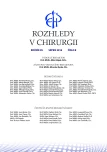Perforation of the right ventricle of the heart as a complication of CT guided percutaneous drainage of a subphrenic abscess – a case report
Authors:
A. Zatloukal 1; M. Lerch 1,2; P. Zonča 1,2
Authors‘ workplace:
Chirurgická klinika FN Ostrava, přednosta: doc. MUDr. P. Zonča, Ph. D., FRCS
1; Lékařská fakulta, Ostravská univerzita v Ostravě, děkan: doc. MUDr. P. Zonča, Ph. D., FRCS, vedoucí katedry chirurgických oborů: doc. MUDr. P. Vávra, Ph. D.
2
Published in:
Rozhl. Chir., 2016, roč. 95, č. 8, s. 333-335.
Category:
Case Report
Overview
Introduction:
CT guided percutaneous drainage is currently the gold standard in the treatment of abdominal fluid collections, having substituted open surgical drainage in many cases. It burdens the patient less than surgical drainage. Its efficiency is comparable to standard surgical drainage when properly indicated. It is readily available even in smaller hospitals. However, this method can also have many complications, which originate most often from an improperly targeted drainage catheter.
Case report:
The authors describe a case report of a 55 years old man with a right-sided subphrenic abscess. The right ventricle of the heart was perforated during a CT guided percutaneous drainage. The bleeding was minimal, but the patient suffered a profound septic shock as a result of massive bacteremia during direct communication of the contents of the abscess cavity with blood circulation. He was operated immediately. The right ventricle was sutured, and the subphrenic abscess was drained. There were no complications after the operation, and the patient was discharged on day 17 after the surgery.
Conclusion:
The CT guided drainage of an abdominal abscess or a fluid collection in a risk area should be preferably done in hospitals whose therapeutic portfolio also includes the handling of serious complications.
Key words:
heart injury − drainage
Sources
1. Levin DC, Eschelman D, Parker L, et al. Trends in use of percutaneous versus open surgical drainage of abdominal abscesses. J Am Coll Radiol 2015;12:1247−50.
2. Lorenz J,Thomas JL. Complications of percutaneous fluid drainage. Semin. Intervent. Radiol 2006;23:194−204.
3. Stolt V, Cook S, Räber L, et al. Amplatzer Septal Occluder to treat iatrogenic cardiac perforations. Catheter Cardiovasc Interv 2012;79:263−70.
4. Petrov I, Dimitrov C. Closing of a right ventricle perforation with a vascular closure device. Catheter Cardiovasc Interv 2009;74:247−50.
5. Kunishige H, Ishbashi Y, Kawasaki M, et al. Surgical treatment of iatrogenic cardiac injury induced by pericardiocentesis; report of a case. Kyobu Geka 2011;64:419−21.
6. Goltz JP, Gorski A, Böhler J, et al. Iatrogenic perforation of the left heart during placement of a chest drain. Diagn Interv Radiol 2011;17:229−31.
7. Kopec SE, Conlan AA, Irwin RS. Perforation of the right ventricle: a complication of blind placement of a chest tube into the postpneumonectomy space. Chest 1998;114:1213−5.
8. Šimek M, Marcián P, Hájek R, et al. Poranění srdce a velkých cév. Desetiletá zkušenost jednoho centra. V. sjezd české společnosti kardiovaskulární chirurgie – poster, Nov 2012.
9. Konečný J, Šimek M, Klváček A, et al. Penetrující poranění srdce – přehled. Kardiol Rev Int Med 2014;16:512−515.
Labels
Surgery Orthopaedics Trauma surgeryArticle was published in
Perspectives in Surgery

2016 Issue 8
Most read in this issue
- Surgical approaches to pineal region – review article
- Treatment of acute appendicitis: Retrospective analysis
- Supravesical hernia as a rare cause of inguinal herniation and its laparoscopic treatment with TAPP approach
- Free-floating thrombus in the internal carotid artery treated by anticoagulation and delayed carotid endarterectomy
